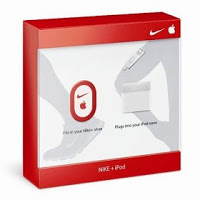As I’ve mentioned elsewhere on this blog, and much to my wife’s chagrin, I’m a complete gadget junkie. Thus, to my good fortune, my initiation into the world of distance running about two years ago roughly coincided with the appearance on the market of several new high-tech running gadgets: the Garmin Forerunner 205 and 305, and the Nike+ system. What follows is a review of my experience using the latter of these two systems (for my Garmin Forerunner review click here)
 The Nike+ System
The Nike+ System
Back in 2007, I was just beginning my life as a runner, and I was looking for tools to help me progress. The Garmin Forerunner and Nike+ systems both had instant appeal to my techie side, however I was initially hesitant to invest the several hundred dollars (at the time) needed to buy a Forerunner. I was also swept up in the excitement surrounding the introduction of the Nike+ system, and my first pair of “real” running shoes were the Nike Air Structure Triax 10. Since I owned an Ipod Nano and had shoes that could accomodate the little Nike+ footpod accelerometer internally, I decided to give Nike + a try. In the interest of full disclosure, I’ll say at the outset that I no longer use the Nike+. However, that doesn’t necessarily mean that I wouldn’t recommend it to anyone since it does have its benefits and uses. The Nike+ certainly helped my running in those early days, and the motivation provided by the on-line Nike+ challenges was great. I liked being able to gauge my pace, track distance, and record my runs on-line. But for a perfectionist like myself, the Nike+ has some serious drawbacks.
The most serious problem I have with the Nike+ is that it’s only really accurate if you run at the same steady pace on every run, and stick to more-or-less flat ground. Any deviation from the pace you calibrate it at messes up both the pacing data as well as the distance recording for your run, and at times I found these measurements to be wildly off. Now, for many runners this is not a big deal, but if you like to mix up your training and include things like intervals, tempo runs, and long, slow runs, the Nike+ comes up way short. Furthermore, for me as a road racer, tenths of a mile and accurate pacing data matter a lot, so these shortcomings presented some major problems. That being said, I’m glad that I used it, and it did help a lot when I first started out. Even after I upgraded to the Garmin Forerunner 205, I did still continue to use Nike+ for treadmill runs (this probably goes without saying, but GPS doesn’t work on a treadmill). The Nike+ recordings on a treadmill are accurate enough, and in my case are more accurate than the readout of my treadmill’s own data console (it has never worked quite right for some reason).
I do believe that the Nike+ can be a valuable tool for a new or recreational runner. It’s cheap (; see also the link at the bottom of this post), so it won’t dent your wallet too much if you decide you don’t like it, and the on-line community is active and interesting. If you’re a new runner just starting out, or an experienced runner who tends to run most of your runs at the same pace, than the Nike+ would be a great addition to your running toolbox and is sure to provide some motivation for you to get out for a run. For a quick overview of Nike+, check out the following video:
To summarize again, Nike+ is a neat and fun little tool, but it has some major drawbacks for a serious runner who cares about missing tenths of a mile or needs really accurate pacing information. However, with the low price tag, I’d recommend giving this system a try if you’re just getting into running and need a little motivational jumpstart.















Speak Your Mind